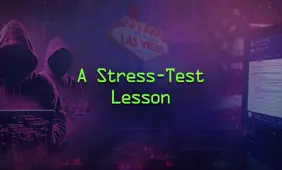R. Paul Wilson On: Unmasking the Art of Pickpocketing Techniques

Whatever our profession or pursuits, all of us are potential targets for crimes of deception. As gamblers, we have the added concern of legal forms of deceit, such as reduced odds or psychological strategies from opponents, so it is essential that we learn to pause and consider our surroundings from time to time. A more proactive approach is to try to anticipate potential pitfalls, and to this end, I’d like to invite you on a short visit to the other side of the tracks.
As I write this, I am in Madrid, a city with great food, art and architecture, a thriving nightlife and an energy that rarely fades from dusk to dawn. In addition to culture and land-based casinos, there is a criminal element that preys on visitors and tourists and while we will explore that underbelly more deeply in the future, for today, let’s consider the army of pickpockets who prowl the metro, the Plaza Mayor and crowded Sunday markets.
For those of you thinking this might not apply to you, consider that if you gamble with cash and carry that cash outside of a land-based casino or other gambling venue (in any city), you are an obvious target for determined thieves.
Exploring the Ingenious World of Pickpocketing Techniques
I have a passion for great pickpocketing techniques, but pickpocketing techniques are rarely as skillful or clever as they seem in the movies, but by studying gangs of pickpockets around Madrid, Paris and Barcelona, I’ve learned how the pinch (where a wallet or purse is grasped firmly for the steal) is just one (often artless) element. What really interests me are the simple but ingenious strategies used to get close to a victim without raising suspicion.
I’ve spent many hours drinking over-priced coffee in Spanish tourist traps just to monitor pickpockets in action while they follow potential targets, moving in at exactly the right moment to intercept their unsuspecting prey. In Plaza Major, crowds gather on market days where people are forced together, but on other days, thieves wait till people pass through bottlenecks in surrounding cloisters, converging and separating with just enough time to unzip an unprotected bag or squeeze a wallet from an unwary pocket.
In the Metro, I see pairs of pickpockets sandwich other passengers between them at entrance gates, one pretending their card doesn’t work, forcing the person behind to be trapped in a mini human traffic jam so a pickpocket in the back can easily pull something from the victim’s bag. It’s not just that this simple ploy affords time and access to someone’s belongings, it’s that the target is never aware of their personal space being invaded because of the seemingly natural - and momentary - situation the pickpockets have engineered.
We could analyze the many ways a pickpocket does this, but what’s more interesting for our purposes is how the approach is invisible to someone’s awareness, whereas a clumsy or less artful approach might alert the target before a “dip” has a chance to “reach” for the money.
Mastering the Craft of Pickpocketing and Deception
In Las Vegas, crowds often gather to cross the street at major intersections like Flamingo and The Strip, so a few years ago, the city installed raised walkways to make crossing safer, easier and quicker, but this also offered new opportunities for criminals. People crammed onto escalators are easy prey, and the walkways can be so crowded that walking through people in the opposite direction is like a visit to the supermarket for a skilled thief.
Pickpocketing has many nuances and subtleties employed by real experts, but outside in the real world, most pickpockets are just criminals with sticky fingers, and all they need is to get close to you and your stuff. The success of this form of theft relies on people having no idea how or where it happened when timing ensures they were suitably (and physically) distracted.
In an airport, luggage thieves approach us with a variety of reasons or stories while their “associates” tap into unguarded bags, and in a casino, rail thieves squeeze into busy craps games to snatch a few unguarded black chips from the nearest player.
Every scam, from rank theft to sophisticated fraud, begins by getting close to the victim without waking up their suspicion.
Learning from this, I try to recognize similar strategies applied to other situations, from banking and crypto to gambling and investing. This has proven to be a productive exercise; the more I learn from watching clever criminals, the more I learn to recognize variations applied to other walks of life.
How Can a Scammer Get Close Enough to Steal?
The key to that awareness is not just knowledge but imagination and while I would never encourage you to turn to crime, considering the possibilities and imagining how we might take a criminal advantage ourselves is a powerful, productive exercise but don’t fall into the trap of thinking we can prevent all deception, just because we’re aware of it.
For example, I once saw someone reach into a backpack on Fremont Street in Las Vegas while the owner was watching the overhead light show (an absolute gift for pickpockets) despite the fact the victim was wearing the backpack on their front to prevent exactly what was happening to her! Thankfully, two police officers were homing in on this brazen thief, and he soon got a face full of pavement while his victim screamed at him while computer-generated jets roared overhead.
The Fremont Experience can be quite a show!
Through the Eyes of a Thief
Wandering Madrid and Paris (in which quite topically the renowned movie "Pickpocket" was shot in 1959), I try to look through the eyes of a thief, and the sad truth is that most people are distracted and vulnerable, even if they take precautions. Sure, you can wear your backpack like a baby on your chest but why not just relocate your most valuable belongings to an inaccessible money belt and only keep things you can afford to lose behind exposed zippers and buttons?
The same is true for our online activity, where we can manage our resources so that more valuable accounts are most protected and rarely exposed, using accounts we can afford to lose for day-to-day transactions. This way, our losses are less damaging should the worst happen. This is the same as wandering around a busy city with an extra wallet you can afford to lose or give to a mugger while your real stash is under your shirt.
Take a moment to flirt with the dark side and ask yourself where and when you might be most vulnerable to a pickpocket; image yourself as that pickpocket, and you’ll be surprised how easy a target you make (and if you think not, you don’t know enough about how pickpockets operate).
Now repeat this exercise with your personal data, your online activity and other sources of finance. How would someone get close to those? How might a bad actor gain access to a digital wallet, and how much would that impact you? We’re going to look at those methods in detail, but for now, just imagining how we would steal from ourselves may expose weaknesses that others can already see.





Review this Blog
Leave a Comment
User Comments
comments for R. Paul Wilson On: Unmasking the Art of Pickpocketing Techniques